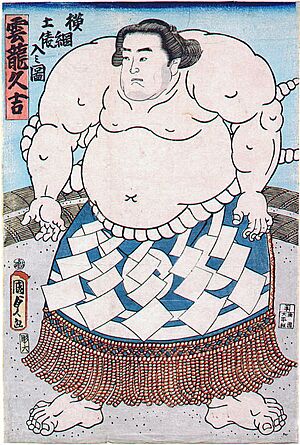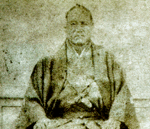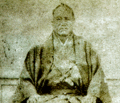Unryū Kyūkichi facts for kids
Quick facts for kids Unryū Kyūkichi |
|
|---|---|
| 雲龍 久吉 | |

Woodblock print of Unryū by Utagawa Kunisada II, 1864
|
|
| Personal information | |
| Born | Shiozuka Kyūkichi 1822 Yanagawa, Chikugo, Japan |
| Died | June 15, 1890 (aged 68) |
| Height | 1.78 m (5 ft 10 in) |
| Weight | 135 kg (298 lb) |
| Career | |
| Stable | Jinmaku → Oitekaze |
| Record | 127-32-55 15draws-5holds(Makuuchi) |
| Debut | November, 1847 |
| Highest rank | Yokozuna (September 1861) |
| Retired | February, 1865 |
| Elder name | Oitekaze |
| Championships | 7 (Makuuchi, unofficial) |
| * Up to date as of October 2007. | |
Unryū Kyūkichi (Japanese: 雲龍 久吉, 1822 – June 15, 1890; name also read as Unryū Hisakichi) was a famous Japanese sumo wrestler. He came from Yanagawa, a place in Japan. He became the 10th yokozuna, which is the highest rank in sumo. There is a special sumo ceremony style named after him. However, it's not certain if he actually performed that exact style himself.
Contents
Unryū's Early Life and Sumo Start
Unryū Kyūkichi was born in 1822. His birth name was Shiozuka Kyūkichi. He later changed it to Satō Kitarō. When he was 11, he lost his parents and grandmother. He had to work hard to support his three younger brothers and sisters.
In 1841, a group of sumo wrestlers from Edo (now Tokyo) visited his area. They were on a tour to cheer people up after a time of hunger. The leader, Oitekaze Kitarō, was a top-ranked wrestler. He saw young Kyūkichi at a local sumo tournament. Kyūkichi was shy, but Oitekaze was amazed by how easily he could beat his opponents.
Kyūkichi started his sumo career in 1845. He joined the Jinmaku stable in Osaka sumo. He was given the ring name, or shikona, of Unryū Kyūkichi. He kept this name his whole career. In 1847, he moved to Edo sumo. There, he wrestled for the Yanagawa Domain. He reached the top makuuchi division in 1852.
Unryū was a very skilled fighter. He won the equivalent of four tournaments in a row. His wrestling style was careful and controlled. He even showed off his skills to Matthew C. Perry when Perry visited Japan.
Becoming a Yokozuna
Unryū Kyūkichi was promoted to ōzeki in January 1858. The ōzeki rank is just below yokozuna. In September 1861, he received the special yokozuna license. This license came from the House of Yoshida Tsukasa, a family that has long been important in sumo.
As a yokozuna, Unryū was known for his kindness. He held special sumo shows in his hometown. He gave the money he earned to local shrines. He even donated a torii gate and lanterns. More than 10,000 people came to watch his shows. These events were the most popular in Yanagawa's history. In the top makuuchi division, he won 127 matches and lost only 32. This means he won almost 80% of his fights!
Life After Sumo: Retirement
Unryū retired from sumo in February 1865. After retiring, he took on the name Oitekaze. He became the chairman of the Edo Sumo Association. He was known for being very honest. He continued to give gifts to temples. He gave gates to the Ekō-in temple and the Asakusa Shrine.
It is believed that Unryū helped make the first three yokozuna in history official. Before him, these wrestlers (Akashi Shiganosuke, Ayagawa Gorōji, and Maruyama Gondazaemon) were seen more as legends. Unryū helped confirm that they were real, important wrestlers. He passed away on June 15, 1890.
The Yokozuna Ring Ceremony Style
There is a special yokozuna ceremony called dohyō-iri. One of the styles for this ceremony is named after Unryū. People said his ritual dance was very beautiful. However, it's not fully clear if he performed the exact movements of the style now called "Unryū-style."
There has been some confusion about the names of the Unryū and Shiranui styles. Some believe the names were accidentally switched. This happened because a sumo expert, Kozo Hikoyama, made a mistake. He said that the style performed by Tachiyama Mineemon was the "Shiranui-style." But it was actually created by Unryū. Because Hikoyama was so respected, no one corrected him. So, the "Shiranui" name stuck to Unryū's style.
Later, people looked at old pictures and woodblock prints. They found evidence of what styles Unryū and Shiranui actually performed. For example, a picture shows Unryū doing a yokozuna ring-entering with his arms out wide. This is how the Shiranui-style is done today. And a photo shows Shiranui posing in what is now called the Unryū-style. This suggests the names of the styles were indeed mixed up over time.
Images for kids




